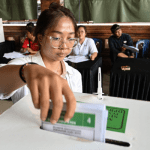India will begin voting in phases starting on April 19 to elect a new Parliament, this is according to the country’s election authority.
Nearly one billion people are eligible to cast ballots in the world’s largest election.
The election pits two-term strongman Prime Minister Narendra Modi and his regional allies against a bickering alliance of two dozen opposition parties.
A victory would make Mr Modi, 73, the second prime minister after Jawaharlal Nehru, India’s independence hero and its first prime minister, to win a third straight term.
Mr Modi and his party have been in campaign mode for months before the dates for the vote were announced.
In his speeches, Mr Modi has been showcasing economic growth during his two terms, which has resulted in India becoming the fastest growing major economy in the world at present, investment in infrastructure as well as welfare programmes for the poor.
A main talking point has also been his party’s agenda for Hindu reawakening, including the inauguration of a grand temple to Lord Ram on the site of a destroyed mosque.
Mr Modi has set a target of 370 seats for the BJP and 400-plus for the National Democratic Alliance (NDA) it heads in the 543-member Lower House of Parliament, up from the 303 the BJP won and more than the 350 the NDA won in 2019.
Mr Modi will be challenged by an alliance of some two dozen opposition parties led by the main opposition Congress party called India, or the Indian National Developmental Inclusive Alliance.
Nearly 970 million people are registered to vote at more than one million polling stations in the mammoth electoral exercise, with 2,400 political parties likely to contest.














